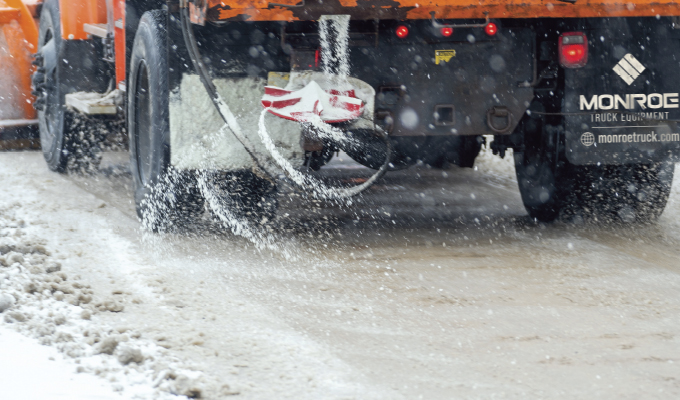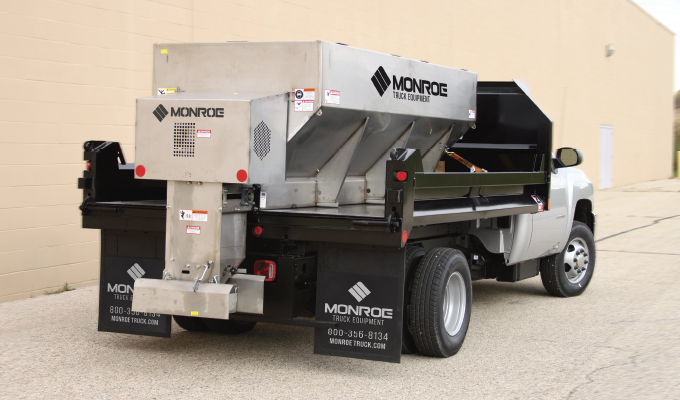There are several considerations contractors have to think through when choosing a spreader or sprayer. Each option has advantages and disadvantages, meaning there’s no “right” answer for what spreader or sprayer to choose.
The snow and ice management experts at Monroe Truck Equipment put together this guide on three common snow and ice management systems: V-Box, tailgate, and liquid spreader systems.
Below, we’ve outlined questions to ask about your business and environment when investing in a new spreader or sprayer option and have outlined the advantages of each system.
WHAT TO CONSIDER
The first and most important step to take when deciding what spreader or sprayer option to invest in is to consider the goals and limitations of your business and your region.
These questions will help you narrow down which investment makes the most sense for the work you do, the size of your team, and how you want to grow your business in the future.
Questions to ask:
- What kind of properties do you service? Are you a large contractor responsible for roadways, large parking lots, or other expansive properties? Or perhaps your team specializes in residential walkways, small paved areas, and smaller properties. The scale of properties you are responsible for will inform your choice.
- What capacities does your truck have? Understanding your truck’s Gross Vehicle Weight Rating (GVWR) will help you decide which spreader or sprayer option to choose and will likely make an impact on what kind of services you can offer. A lower GVWR pairs well with workers who are responsible for several smaller properties, but a higher GVWR is more aligned with companies responsible for larger areas, as they will not have to refill material as often.
- How many team members do you have? If you have a team of more than 5 to 8 people, there is more flexibility in what kind of system you invest in. You may want to diversify your fleet by investing in a new system and expanding into new types of work.
- What’s your material budget? If material budget is a priority, distribution accuracy will be important. Ground speed controls will help you manage the overall value of your program by monitoring pounds per 1,000 sq ft of granular material.
- Does your community have preferences for material usage? If you work in residential properties or even commercial properties that also have large landscaped areas, the surrounding community may have preferences about the materials used to deice their property. Certain deicers are more harmful to grass, plants, and animals than others. If there are different material preferences for different locations you are responsible for clearing, time required for material change out is something to consider when investing in a deicing system.
SYSTEM CHOICE
V-box versus tailgate versus liquid system? There’s no right or wrong answer. After going through the questions above, compare your answers with the advantages and disadvantages of each system below:
V-Box System
A V-Box System is often the choice for contractors responsible for large expanses of property and have trucks with a higher GVWR. This is because they hold far more deicing material and can protect large expanses of property without needing refilling.
Pros:
- Material costs are often less because you can buy in bulk
- Does not require the dump body to be raised
- Load your hopper less often because it can store more material
- Tackle more work in one sweep, potentially handling more accounts in a day
- Easy to maneuver and refill
- Can be mounted directly onto a chassis or slid into a dump body
Cons:
- More moving parts means more maintenance and possible downtime
- More difficult to convert from season to season
- Greater initial investment
Tailgate Systems
Tailgate systems are often the choice for contractors who are responsible for smaller residential properties or are doing snow and ice removal on the side of other work.
Pros:
- Less expensive and straightforward repairs
- Easy installation and removal
- Easy and inexpensive entry into the industry
Cons:
- Requires dump body to be raised, which can cause additional safety hazards
Liquid Systems
As companies focus more on sustainability, you may encounter clients searching for more sustainable solutions for winter maintenance. An option to consider would be equipping your fleet with a direct liquid application, alternatively referred to as anti-icers or deicers.
Material applied before a storm event is considered anti-icing, if the direct liquid is used during a storm event it is considered deicing. Using direct liquid can often reduce the amount of granular material used during a storm event if required, resulting in cost savings, and offering a more sustainable option.
Pros:
- Reduces the impact on the environment and groundwater tables
- Requires less material to be effective—can penetrate paved surfaces
- Can greatly save plowing and labor time as it reduces the amount of snow and ice that can collect and bond on the road surface
- Can be precisely calibrated to minimize the risk of over or under application
Cons:
- Requires more experience and understanding of the system for effective applications and product management
- Needs to be used in conjunction with other snow and ice management systems
CONSULT EXPERTS
Armed with more information about your choice ahead, now is the time to sit down with your trusted dealer and talk through the specific options that will help you meet your business goals and result in long-term ROI.
ABOUT THE AUTHOR
Jim Smith is the director of sales in the commercial division of Monroe Truck Equipment. Find out more about road clearing equipment and get advice from the experts, visit www.commercial.monroetruck.com.





